Roles of Nurses in Treatment Assignment PDF
VerifiedAdded on 2021/06/18
|16
|4473
|50
AI Summary
Contribute Materials
Your contribution can guide someone’s learning journey. Share your
documents today.
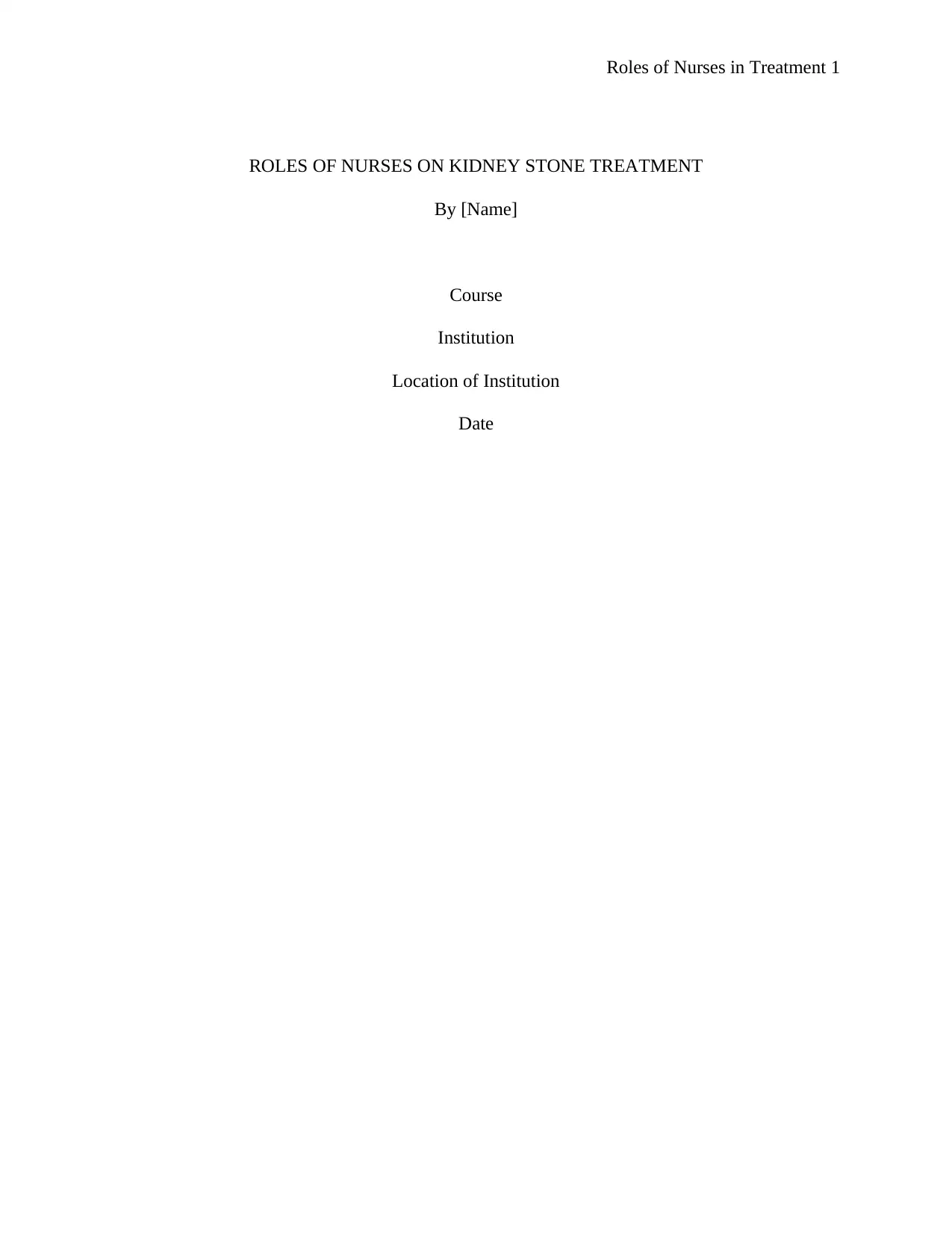
Roles of Nurses in Treatment 1
ROLES OF NURSES ON KIDNEY STONE TREATMENT
By [Name]
Course
Institution
Location of Institution
Date
ROLES OF NURSES ON KIDNEY STONE TREATMENT
By [Name]
Course
Institution
Location of Institution
Date
Secure Best Marks with AI Grader
Need help grading? Try our AI Grader for instant feedback on your assignments.
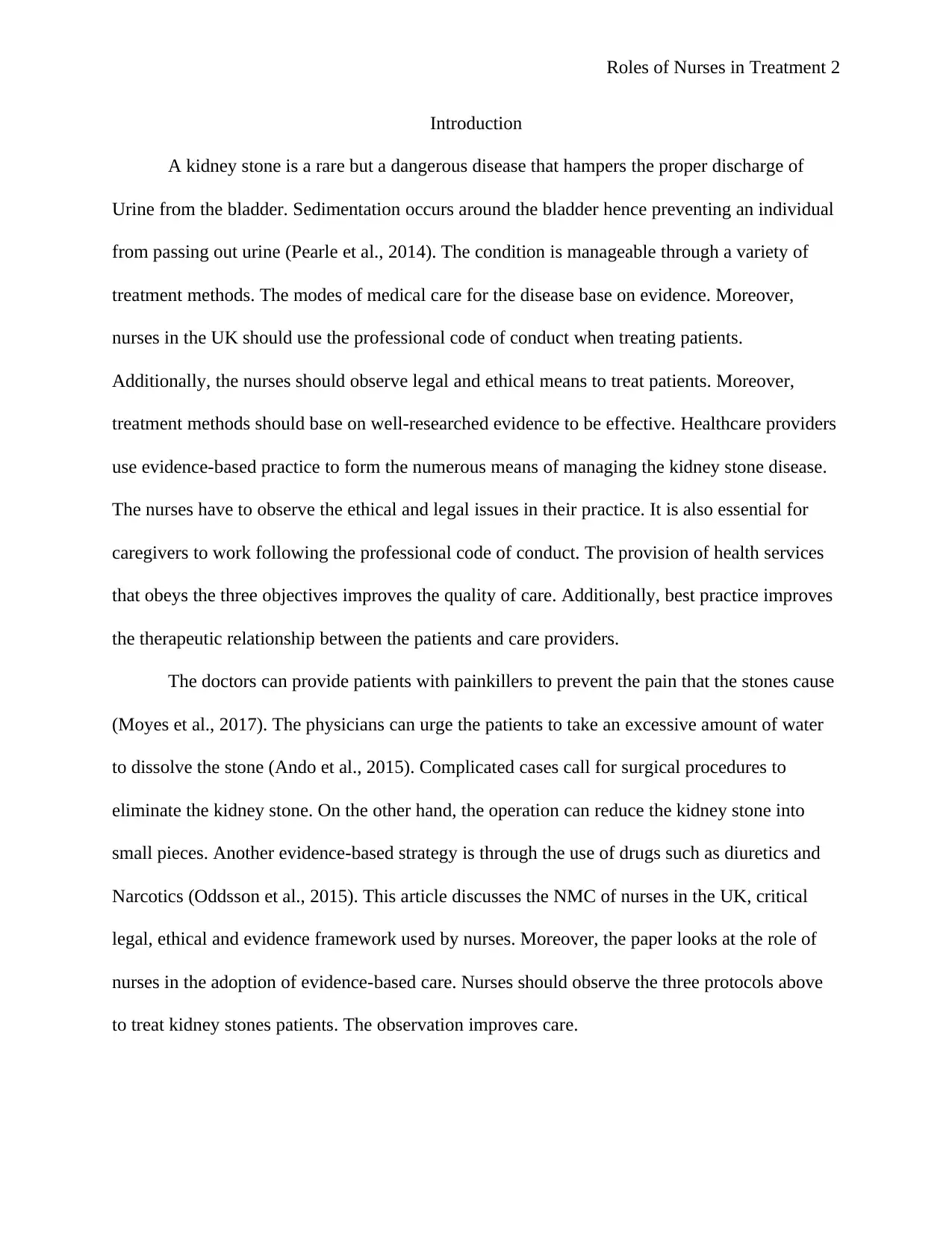
Roles of Nurses in Treatment 2
Introduction
A kidney stone is a rare but a dangerous disease that hampers the proper discharge of
Urine from the bladder. Sedimentation occurs around the bladder hence preventing an individual
from passing out urine (Pearle et al., 2014). The condition is manageable through a variety of
treatment methods. The modes of medical care for the disease base on evidence. Moreover,
nurses in the UK should use the professional code of conduct when treating patients.
Additionally, the nurses should observe legal and ethical means to treat patients. Moreover,
treatment methods should base on well-researched evidence to be effective. Healthcare providers
use evidence-based practice to form the numerous means of managing the kidney stone disease.
The nurses have to observe the ethical and legal issues in their practice. It is also essential for
caregivers to work following the professional code of conduct. The provision of health services
that obeys the three objectives improves the quality of care. Additionally, best practice improves
the therapeutic relationship between the patients and care providers.
The doctors can provide patients with painkillers to prevent the pain that the stones cause
(Moyes et al., 2017). The physicians can urge the patients to take an excessive amount of water
to dissolve the stone (Ando et al., 2015). Complicated cases call for surgical procedures to
eliminate the kidney stone. On the other hand, the operation can reduce the kidney stone into
small pieces. Another evidence-based strategy is through the use of drugs such as diuretics and
Narcotics (Oddsson et al., 2015). This article discusses the NMC of nurses in the UK, critical
legal, ethical and evidence framework used by nurses. Moreover, the paper looks at the role of
nurses in the adoption of evidence-based care. Nurses should observe the three protocols above
to treat kidney stones patients. The observation improves care.
Introduction
A kidney stone is a rare but a dangerous disease that hampers the proper discharge of
Urine from the bladder. Sedimentation occurs around the bladder hence preventing an individual
from passing out urine (Pearle et al., 2014). The condition is manageable through a variety of
treatment methods. The modes of medical care for the disease base on evidence. Moreover,
nurses in the UK should use the professional code of conduct when treating patients.
Additionally, the nurses should observe legal and ethical means to treat patients. Moreover,
treatment methods should base on well-researched evidence to be effective. Healthcare providers
use evidence-based practice to form the numerous means of managing the kidney stone disease.
The nurses have to observe the ethical and legal issues in their practice. It is also essential for
caregivers to work following the professional code of conduct. The provision of health services
that obeys the three objectives improves the quality of care. Additionally, best practice improves
the therapeutic relationship between the patients and care providers.
The doctors can provide patients with painkillers to prevent the pain that the stones cause
(Moyes et al., 2017). The physicians can urge the patients to take an excessive amount of water
to dissolve the stone (Ando et al., 2015). Complicated cases call for surgical procedures to
eliminate the kidney stone. On the other hand, the operation can reduce the kidney stone into
small pieces. Another evidence-based strategy is through the use of drugs such as diuretics and
Narcotics (Oddsson et al., 2015). This article discusses the NMC of nurses in the UK, critical
legal, ethical and evidence framework used by nurses. Moreover, the paper looks at the role of
nurses in the adoption of evidence-based care. Nurses should observe the three protocols above
to treat kidney stones patients. The observation improves care.
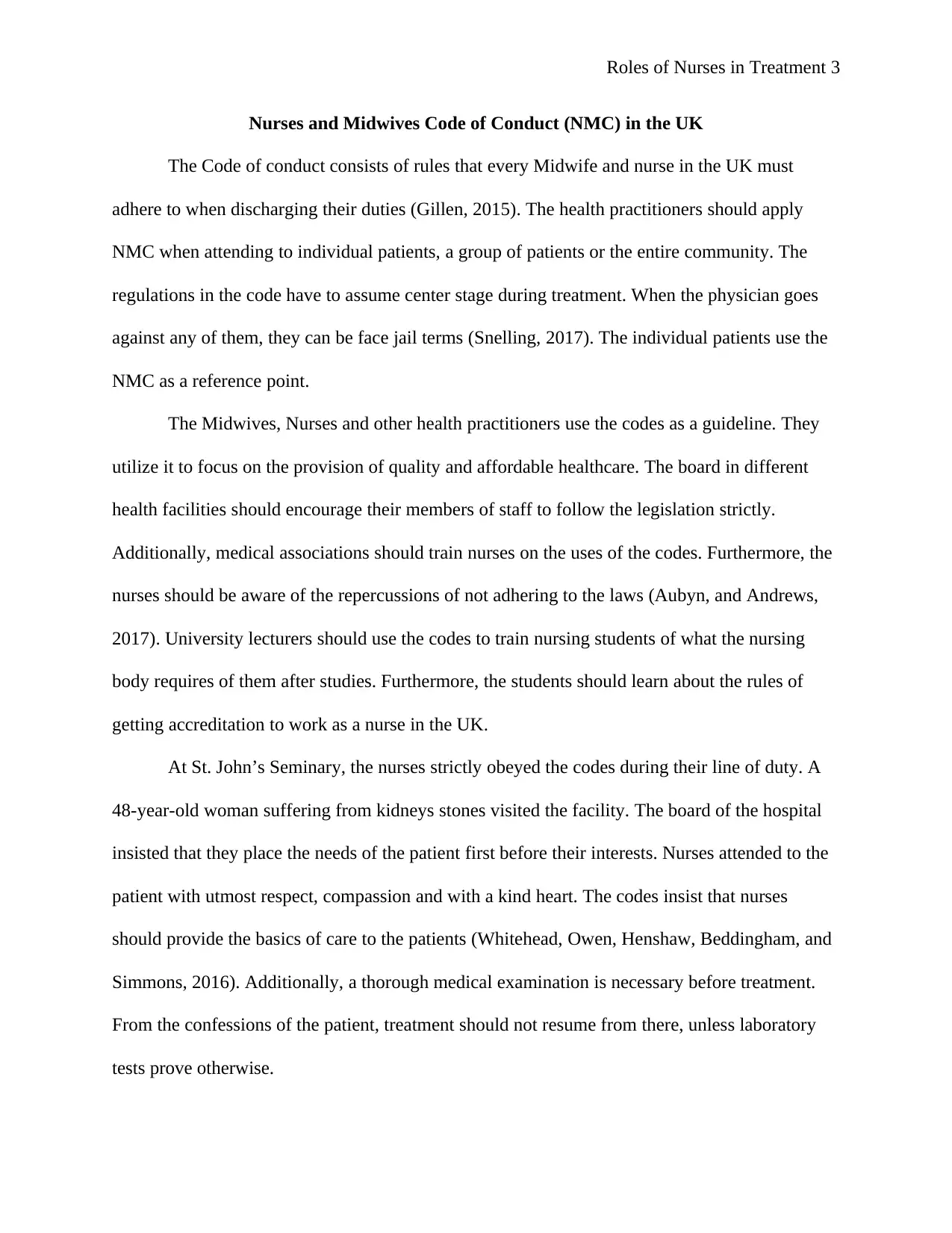
Roles of Nurses in Treatment 3
Nurses and Midwives Code of Conduct (NMC) in the UK
The Code of conduct consists of rules that every Midwife and nurse in the UK must
adhere to when discharging their duties (Gillen, 2015). The health practitioners should apply
NMC when attending to individual patients, a group of patients or the entire community. The
regulations in the code have to assume center stage during treatment. When the physician goes
against any of them, they can be face jail terms (Snelling, 2017). The individual patients use the
NMC as a reference point.
The Midwives, Nurses and other health practitioners use the codes as a guideline. They
utilize it to focus on the provision of quality and affordable healthcare. The board in different
health facilities should encourage their members of staff to follow the legislation strictly.
Additionally, medical associations should train nurses on the uses of the codes. Furthermore, the
nurses should be aware of the repercussions of not adhering to the laws (Aubyn, and Andrews,
2017). University lecturers should use the codes to train nursing students of what the nursing
body requires of them after studies. Furthermore, the students should learn about the rules of
getting accreditation to work as a nurse in the UK.
At St. John’s Seminary, the nurses strictly obeyed the codes during their line of duty. A
48-year-old woman suffering from kidneys stones visited the facility. The board of the hospital
insisted that they place the needs of the patient first before their interests. Nurses attended to the
patient with utmost respect, compassion and with a kind heart. The codes insist that nurses
should provide the basics of care to the patients (Whitehead, Owen, Henshaw, Beddingham, and
Simmons, 2016). Additionally, a thorough medical examination is necessary before treatment.
From the confessions of the patient, treatment should not resume from there, unless laboratory
tests prove otherwise.
Nurses and Midwives Code of Conduct (NMC) in the UK
The Code of conduct consists of rules that every Midwife and nurse in the UK must
adhere to when discharging their duties (Gillen, 2015). The health practitioners should apply
NMC when attending to individual patients, a group of patients or the entire community. The
regulations in the code have to assume center stage during treatment. When the physician goes
against any of them, they can be face jail terms (Snelling, 2017). The individual patients use the
NMC as a reference point.
The Midwives, Nurses and other health practitioners use the codes as a guideline. They
utilize it to focus on the provision of quality and affordable healthcare. The board in different
health facilities should encourage their members of staff to follow the legislation strictly.
Additionally, medical associations should train nurses on the uses of the codes. Furthermore, the
nurses should be aware of the repercussions of not adhering to the laws (Aubyn, and Andrews,
2017). University lecturers should use the codes to train nursing students of what the nursing
body requires of them after studies. Furthermore, the students should learn about the rules of
getting accreditation to work as a nurse in the UK.
At St. John’s Seminary, the nurses strictly obeyed the codes during their line of duty. A
48-year-old woman suffering from kidneys stones visited the facility. The board of the hospital
insisted that they place the needs of the patient first before their interests. Nurses attended to the
patient with utmost respect, compassion and with a kind heart. The codes insist that nurses
should provide the basics of care to the patients (Whitehead, Owen, Henshaw, Beddingham, and
Simmons, 2016). Additionally, a thorough medical examination is necessary before treatment.
From the confessions of the patient, treatment should not resume from there, unless laboratory
tests prove otherwise.
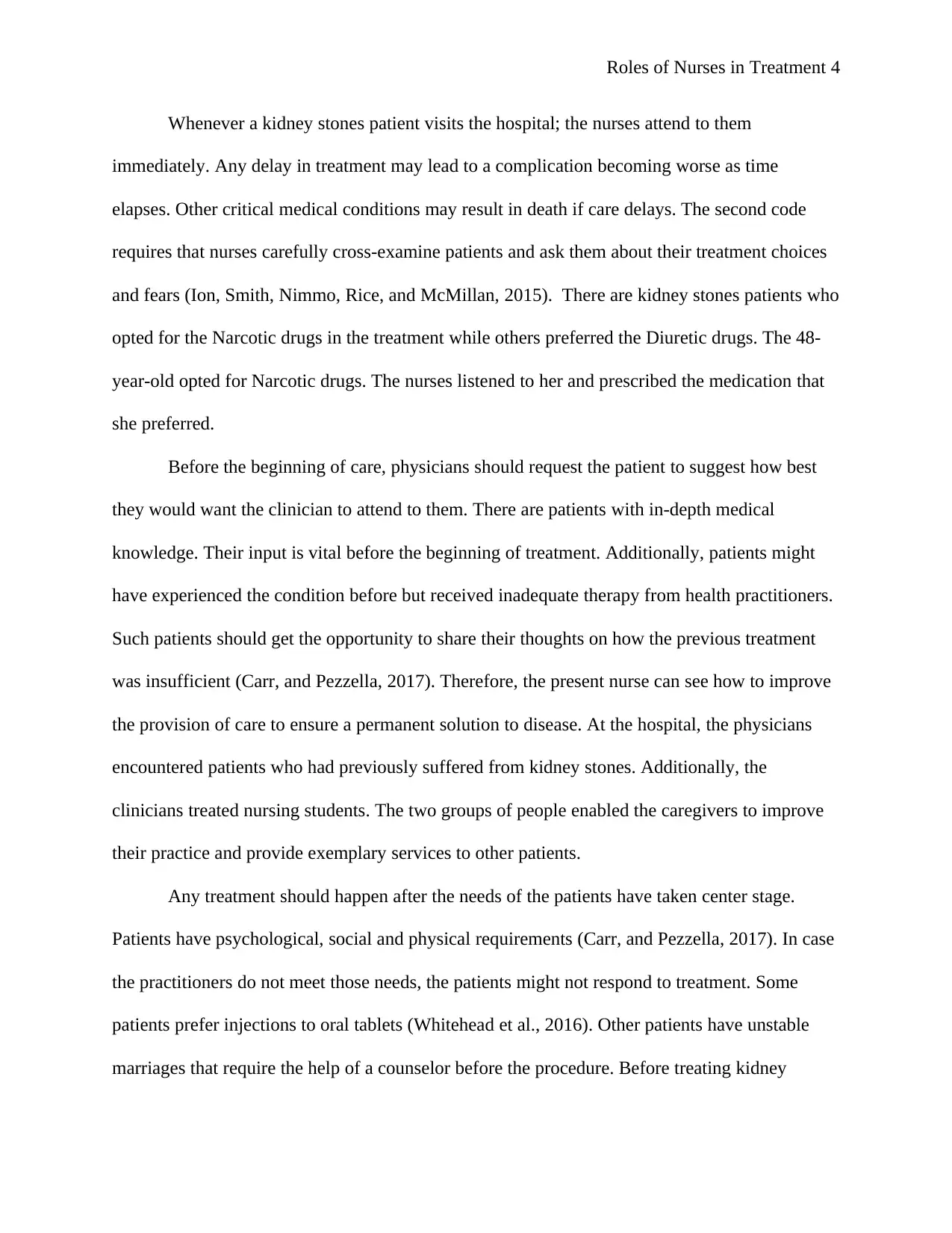
Roles of Nurses in Treatment 4
Whenever a kidney stones patient visits the hospital; the nurses attend to them
immediately. Any delay in treatment may lead to a complication becoming worse as time
elapses. Other critical medical conditions may result in death if care delays. The second code
requires that nurses carefully cross-examine patients and ask them about their treatment choices
and fears (Ion, Smith, Nimmo, Rice, and McMillan, 2015). There are kidney stones patients who
opted for the Narcotic drugs in the treatment while others preferred the Diuretic drugs. The 48-
year-old opted for Narcotic drugs. The nurses listened to her and prescribed the medication that
she preferred.
Before the beginning of care, physicians should request the patient to suggest how best
they would want the clinician to attend to them. There are patients with in-depth medical
knowledge. Their input is vital before the beginning of treatment. Additionally, patients might
have experienced the condition before but received inadequate therapy from health practitioners.
Such patients should get the opportunity to share their thoughts on how the previous treatment
was insufficient (Carr, and Pezzella, 2017). Therefore, the present nurse can see how to improve
the provision of care to ensure a permanent solution to disease. At the hospital, the physicians
encountered patients who had previously suffered from kidney stones. Additionally, the
clinicians treated nursing students. The two groups of people enabled the caregivers to improve
their practice and provide exemplary services to other patients.
Any treatment should happen after the needs of the patients have taken center stage.
Patients have psychological, social and physical requirements (Carr, and Pezzella, 2017). In case
the practitioners do not meet those needs, the patients might not respond to treatment. Some
patients prefer injections to oral tablets (Whitehead et al., 2016). Other patients have unstable
marriages that require the help of a counselor before the procedure. Before treating kidney
Whenever a kidney stones patient visits the hospital; the nurses attend to them
immediately. Any delay in treatment may lead to a complication becoming worse as time
elapses. Other critical medical conditions may result in death if care delays. The second code
requires that nurses carefully cross-examine patients and ask them about their treatment choices
and fears (Ion, Smith, Nimmo, Rice, and McMillan, 2015). There are kidney stones patients who
opted for the Narcotic drugs in the treatment while others preferred the Diuretic drugs. The 48-
year-old opted for Narcotic drugs. The nurses listened to her and prescribed the medication that
she preferred.
Before the beginning of care, physicians should request the patient to suggest how best
they would want the clinician to attend to them. There are patients with in-depth medical
knowledge. Their input is vital before the beginning of treatment. Additionally, patients might
have experienced the condition before but received inadequate therapy from health practitioners.
Such patients should get the opportunity to share their thoughts on how the previous treatment
was insufficient (Carr, and Pezzella, 2017). Therefore, the present nurse can see how to improve
the provision of care to ensure a permanent solution to disease. At the hospital, the physicians
encountered patients who had previously suffered from kidney stones. Additionally, the
clinicians treated nursing students. The two groups of people enabled the caregivers to improve
their practice and provide exemplary services to other patients.
Any treatment should happen after the needs of the patients have taken center stage.
Patients have psychological, social and physical requirements (Carr, and Pezzella, 2017). In case
the practitioners do not meet those needs, the patients might not respond to treatment. Some
patients prefer injections to oral tablets (Whitehead et al., 2016). Other patients have unstable
marriages that require the help of a counselor before the procedure. Before treating kidney
Secure Best Marks with AI Grader
Need help grading? Try our AI Grader for instant feedback on your assignments.
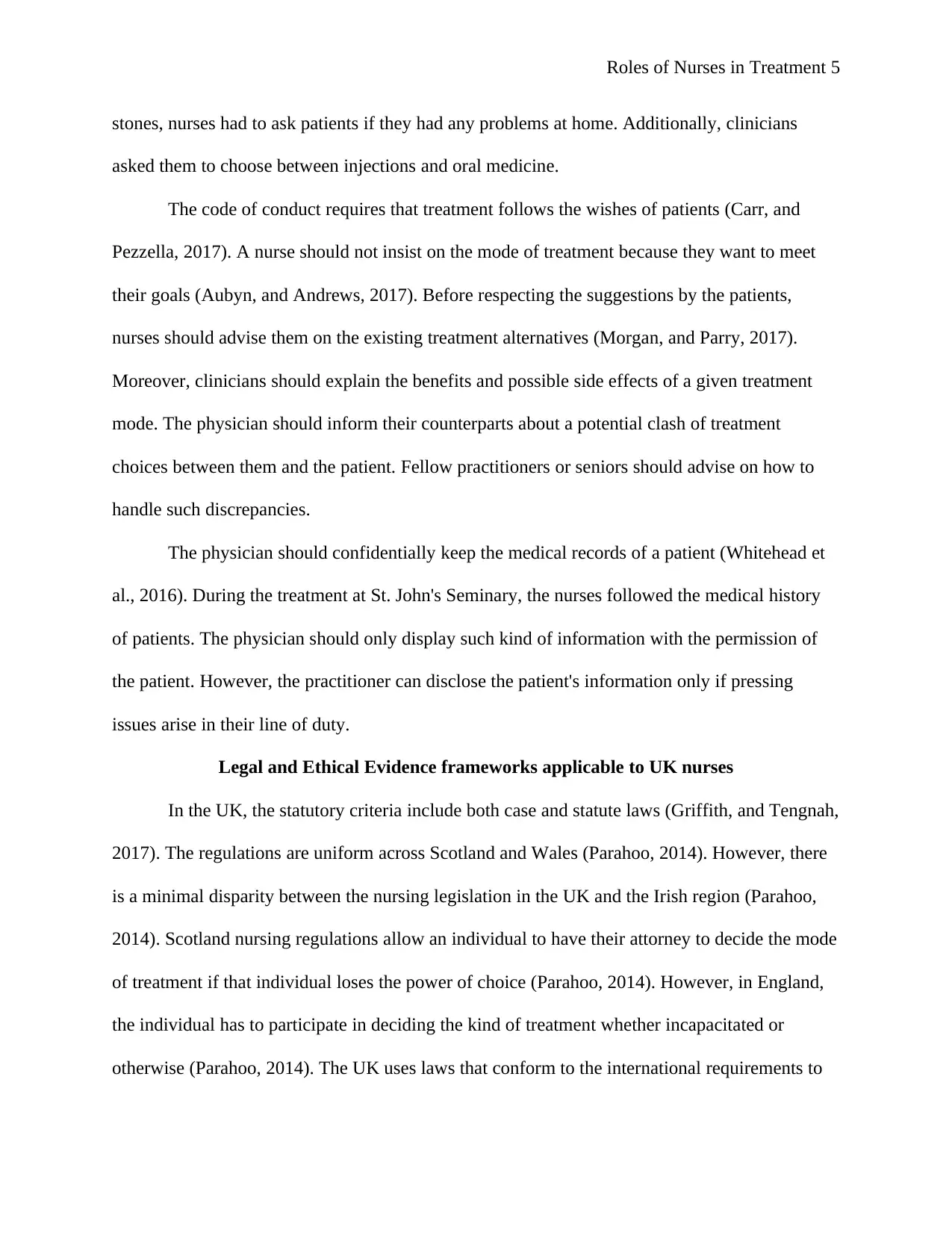
Roles of Nurses in Treatment 5
stones, nurses had to ask patients if they had any problems at home. Additionally, clinicians
asked them to choose between injections and oral medicine.
The code of conduct requires that treatment follows the wishes of patients (Carr, and
Pezzella, 2017). A nurse should not insist on the mode of treatment because they want to meet
their goals (Aubyn, and Andrews, 2017). Before respecting the suggestions by the patients,
nurses should advise them on the existing treatment alternatives (Morgan, and Parry, 2017).
Moreover, clinicians should explain the benefits and possible side effects of a given treatment
mode. The physician should inform their counterparts about a potential clash of treatment
choices between them and the patient. Fellow practitioners or seniors should advise on how to
handle such discrepancies.
The physician should confidentially keep the medical records of a patient (Whitehead et
al., 2016). During the treatment at St. John's Seminary, the nurses followed the medical history
of patients. The physician should only display such kind of information with the permission of
the patient. However, the practitioner can disclose the patient's information only if pressing
issues arise in their line of duty.
Legal and Ethical Evidence frameworks applicable to UK nurses
In the UK, the statutory criteria include both case and statute laws (Griffith, and Tengnah,
2017). The regulations are uniform across Scotland and Wales (Parahoo, 2014). However, there
is a minimal disparity between the nursing legislation in the UK and the Irish region (Parahoo,
2014). Scotland nursing regulations allow an individual to have their attorney to decide the mode
of treatment if that individual loses the power of choice (Parahoo, 2014). However, in England,
the individual has to participate in deciding the kind of treatment whether incapacitated or
otherwise (Parahoo, 2014). The UK uses laws that conform to the international requirements to
stones, nurses had to ask patients if they had any problems at home. Additionally, clinicians
asked them to choose between injections and oral medicine.
The code of conduct requires that treatment follows the wishes of patients (Carr, and
Pezzella, 2017). A nurse should not insist on the mode of treatment because they want to meet
their goals (Aubyn, and Andrews, 2017). Before respecting the suggestions by the patients,
nurses should advise them on the existing treatment alternatives (Morgan, and Parry, 2017).
Moreover, clinicians should explain the benefits and possible side effects of a given treatment
mode. The physician should inform their counterparts about a potential clash of treatment
choices between them and the patient. Fellow practitioners or seniors should advise on how to
handle such discrepancies.
The physician should confidentially keep the medical records of a patient (Whitehead et
al., 2016). During the treatment at St. John's Seminary, the nurses followed the medical history
of patients. The physician should only display such kind of information with the permission of
the patient. However, the practitioner can disclose the patient's information only if pressing
issues arise in their line of duty.
Legal and Ethical Evidence frameworks applicable to UK nurses
In the UK, the statutory criteria include both case and statute laws (Griffith, and Tengnah,
2017). The regulations are uniform across Scotland and Wales (Parahoo, 2014). However, there
is a minimal disparity between the nursing legislation in the UK and the Irish region (Parahoo,
2014). Scotland nursing regulations allow an individual to have their attorney to decide the mode
of treatment if that individual loses the power of choice (Parahoo, 2014). However, in England,
the individual has to participate in deciding the kind of treatment whether incapacitated or
otherwise (Parahoo, 2014). The UK uses laws that conform to the international requirements to
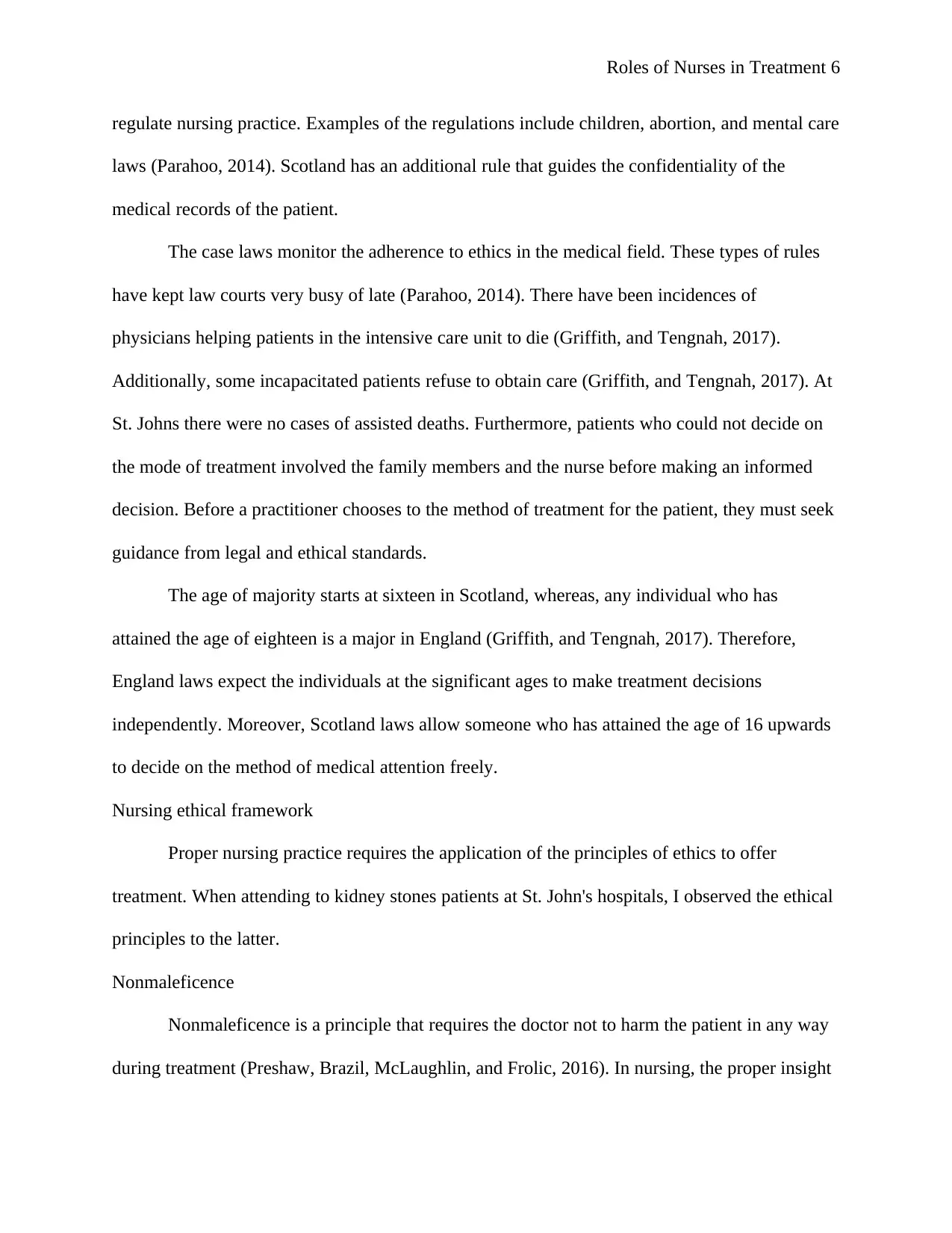
Roles of Nurses in Treatment 6
regulate nursing practice. Examples of the regulations include children, abortion, and mental care
laws (Parahoo, 2014). Scotland has an additional rule that guides the confidentiality of the
medical records of the patient.
The case laws monitor the adherence to ethics in the medical field. These types of rules
have kept law courts very busy of late (Parahoo, 2014). There have been incidences of
physicians helping patients in the intensive care unit to die (Griffith, and Tengnah, 2017).
Additionally, some incapacitated patients refuse to obtain care (Griffith, and Tengnah, 2017). At
St. Johns there were no cases of assisted deaths. Furthermore, patients who could not decide on
the mode of treatment involved the family members and the nurse before making an informed
decision. Before a practitioner chooses to the method of treatment for the patient, they must seek
guidance from legal and ethical standards.
The age of majority starts at sixteen in Scotland, whereas, any individual who has
attained the age of eighteen is a major in England (Griffith, and Tengnah, 2017). Therefore,
England laws expect the individuals at the significant ages to make treatment decisions
independently. Moreover, Scotland laws allow someone who has attained the age of 16 upwards
to decide on the method of medical attention freely.
Nursing ethical framework
Proper nursing practice requires the application of the principles of ethics to offer
treatment. When attending to kidney stones patients at St. John's hospitals, I observed the ethical
principles to the latter.
Nonmaleficence
Nonmaleficence is a principle that requires the doctor not to harm the patient in any way
during treatment (Preshaw, Brazil, McLaughlin, and Frolic, 2016). In nursing, the proper insight
regulate nursing practice. Examples of the regulations include children, abortion, and mental care
laws (Parahoo, 2014). Scotland has an additional rule that guides the confidentiality of the
medical records of the patient.
The case laws monitor the adherence to ethics in the medical field. These types of rules
have kept law courts very busy of late (Parahoo, 2014). There have been incidences of
physicians helping patients in the intensive care unit to die (Griffith, and Tengnah, 2017).
Additionally, some incapacitated patients refuse to obtain care (Griffith, and Tengnah, 2017). At
St. Johns there were no cases of assisted deaths. Furthermore, patients who could not decide on
the mode of treatment involved the family members and the nurse before making an informed
decision. Before a practitioner chooses to the method of treatment for the patient, they must seek
guidance from legal and ethical standards.
The age of majority starts at sixteen in Scotland, whereas, any individual who has
attained the age of eighteen is a major in England (Griffith, and Tengnah, 2017). Therefore,
England laws expect the individuals at the significant ages to make treatment decisions
independently. Moreover, Scotland laws allow someone who has attained the age of 16 upwards
to decide on the method of medical attention freely.
Nursing ethical framework
Proper nursing practice requires the application of the principles of ethics to offer
treatment. When attending to kidney stones patients at St. John's hospitals, I observed the ethical
principles to the latter.
Nonmaleficence
Nonmaleficence is a principle that requires the doctor not to harm the patient in any way
during treatment (Preshaw, Brazil, McLaughlin, and Frolic, 2016). In nursing, the proper insight
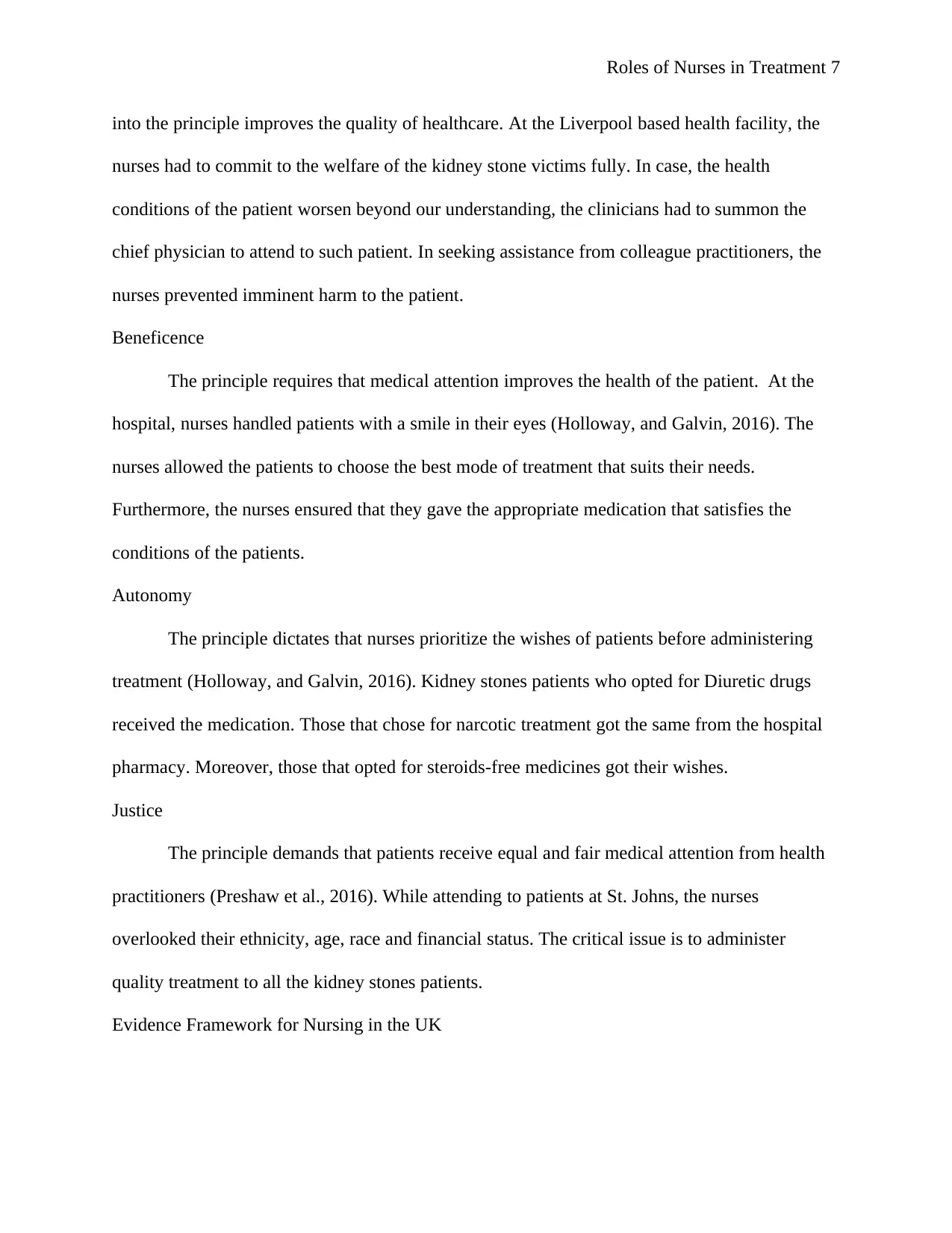
Roles of Nurses in Treatment 7
into the principle improves the quality of healthcare. At the Liverpool based health facility, the
nurses had to commit to the welfare of the kidney stone victims fully. In case, the health
conditions of the patient worsen beyond our understanding, the clinicians had to summon the
chief physician to attend to such patient. In seeking assistance from colleague practitioners, the
nurses prevented imminent harm to the patient.
Beneficence
The principle requires that medical attention improves the health of the patient. At the
hospital, nurses handled patients with a smile in their eyes (Holloway, and Galvin, 2016). The
nurses allowed the patients to choose the best mode of treatment that suits their needs.
Furthermore, the nurses ensured that they gave the appropriate medication that satisfies the
conditions of the patients.
Autonomy
The principle dictates that nurses prioritize the wishes of patients before administering
treatment (Holloway, and Galvin, 2016). Kidney stones patients who opted for Diuretic drugs
received the medication. Those that chose for narcotic treatment got the same from the hospital
pharmacy. Moreover, those that opted for steroids-free medicines got their wishes.
Justice
The principle demands that patients receive equal and fair medical attention from health
practitioners (Preshaw et al., 2016). While attending to patients at St. Johns, the nurses
overlooked their ethnicity, age, race and financial status. The critical issue is to administer
quality treatment to all the kidney stones patients.
Evidence Framework for Nursing in the UK
into the principle improves the quality of healthcare. At the Liverpool based health facility, the
nurses had to commit to the welfare of the kidney stone victims fully. In case, the health
conditions of the patient worsen beyond our understanding, the clinicians had to summon the
chief physician to attend to such patient. In seeking assistance from colleague practitioners, the
nurses prevented imminent harm to the patient.
Beneficence
The principle requires that medical attention improves the health of the patient. At the
hospital, nurses handled patients with a smile in their eyes (Holloway, and Galvin, 2016). The
nurses allowed the patients to choose the best mode of treatment that suits their needs.
Furthermore, the nurses ensured that they gave the appropriate medication that satisfies the
conditions of the patients.
Autonomy
The principle dictates that nurses prioritize the wishes of patients before administering
treatment (Holloway, and Galvin, 2016). Kidney stones patients who opted for Diuretic drugs
received the medication. Those that chose for narcotic treatment got the same from the hospital
pharmacy. Moreover, those that opted for steroids-free medicines got their wishes.
Justice
The principle demands that patients receive equal and fair medical attention from health
practitioners (Preshaw et al., 2016). While attending to patients at St. Johns, the nurses
overlooked their ethnicity, age, race and financial status. The critical issue is to administer
quality treatment to all the kidney stones patients.
Evidence Framework for Nursing in the UK
Paraphrase This Document
Need a fresh take? Get an instant paraphrase of this document with our AI Paraphraser
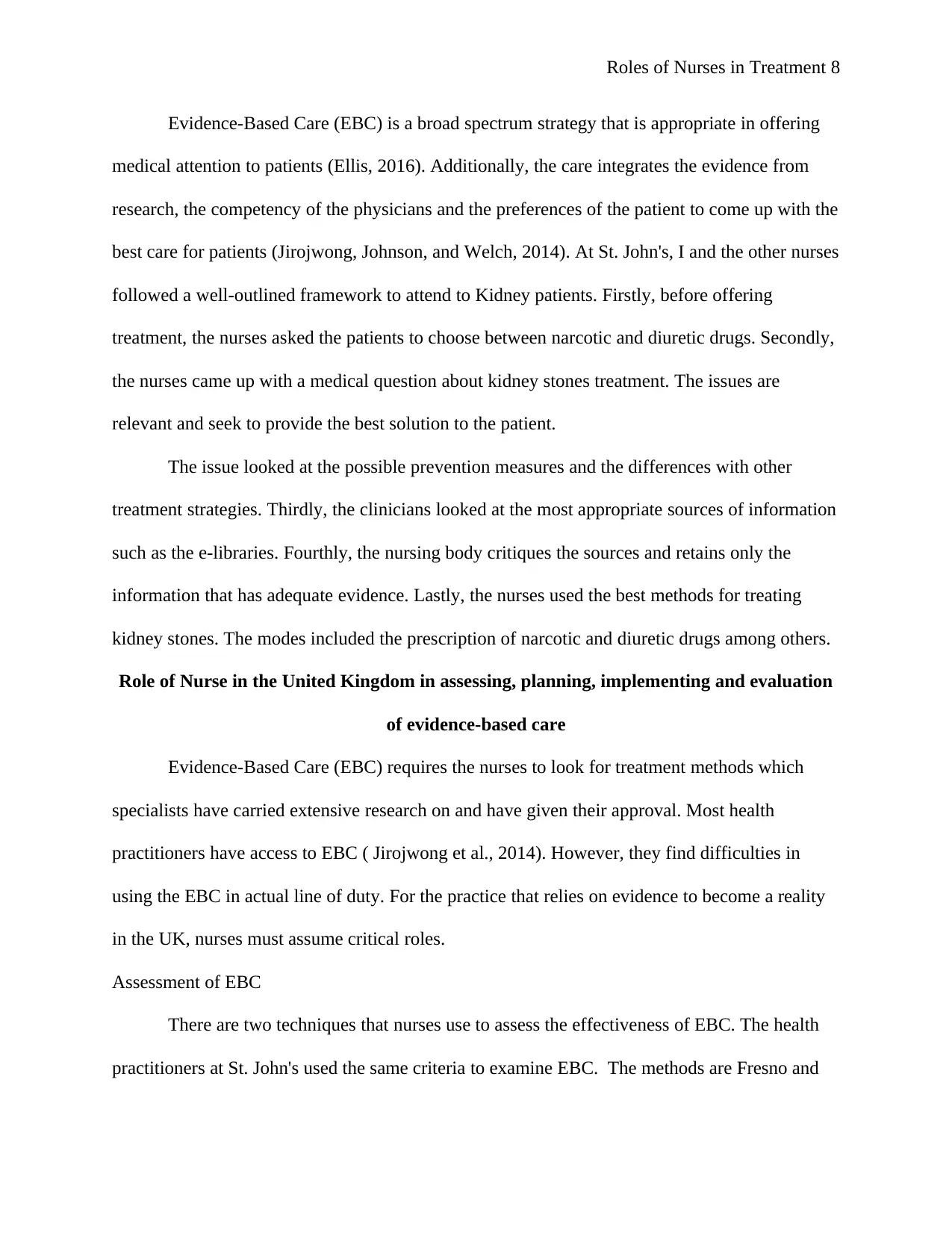
Roles of Nurses in Treatment 8
Evidence-Based Care (EBC) is a broad spectrum strategy that is appropriate in offering
medical attention to patients (Ellis, 2016). Additionally, the care integrates the evidence from
research, the competency of the physicians and the preferences of the patient to come up with the
best care for patients (Jirojwong, Johnson, and Welch, 2014). At St. John's, I and the other nurses
followed a well-outlined framework to attend to Kidney patients. Firstly, before offering
treatment, the nurses asked the patients to choose between narcotic and diuretic drugs. Secondly,
the nurses came up with a medical question about kidney stones treatment. The issues are
relevant and seek to provide the best solution to the patient.
The issue looked at the possible prevention measures and the differences with other
treatment strategies. Thirdly, the clinicians looked at the most appropriate sources of information
such as the e-libraries. Fourthly, the nursing body critiques the sources and retains only the
information that has adequate evidence. Lastly, the nurses used the best methods for treating
kidney stones. The modes included the prescription of narcotic and diuretic drugs among others.
Role of Nurse in the United Kingdom in assessing, planning, implementing and evaluation
of evidence-based care
Evidence-Based Care (EBC) requires the nurses to look for treatment methods which
specialists have carried extensive research on and have given their approval. Most health
practitioners have access to EBC ( Jirojwong et al., 2014). However, they find difficulties in
using the EBC in actual line of duty. For the practice that relies on evidence to become a reality
in the UK, nurses must assume critical roles.
Assessment of EBC
There are two techniques that nurses use to assess the effectiveness of EBC. The health
practitioners at St. John's used the same criteria to examine EBC. The methods are Fresno and
Evidence-Based Care (EBC) is a broad spectrum strategy that is appropriate in offering
medical attention to patients (Ellis, 2016). Additionally, the care integrates the evidence from
research, the competency of the physicians and the preferences of the patient to come up with the
best care for patients (Jirojwong, Johnson, and Welch, 2014). At St. John's, I and the other nurses
followed a well-outlined framework to attend to Kidney patients. Firstly, before offering
treatment, the nurses asked the patients to choose between narcotic and diuretic drugs. Secondly,
the nurses came up with a medical question about kidney stones treatment. The issues are
relevant and seek to provide the best solution to the patient.
The issue looked at the possible prevention measures and the differences with other
treatment strategies. Thirdly, the clinicians looked at the most appropriate sources of information
such as the e-libraries. Fourthly, the nursing body critiques the sources and retains only the
information that has adequate evidence. Lastly, the nurses used the best methods for treating
kidney stones. The modes included the prescription of narcotic and diuretic drugs among others.
Role of Nurse in the United Kingdom in assessing, planning, implementing and evaluation
of evidence-based care
Evidence-Based Care (EBC) requires the nurses to look for treatment methods which
specialists have carried extensive research on and have given their approval. Most health
practitioners have access to EBC ( Jirojwong et al., 2014). However, they find difficulties in
using the EBC in actual line of duty. For the practice that relies on evidence to become a reality
in the UK, nurses must assume critical roles.
Assessment of EBC
There are two techniques that nurses use to assess the effectiveness of EBC. The health
practitioners at St. John's used the same criteria to examine EBC. The methods are Fresno and
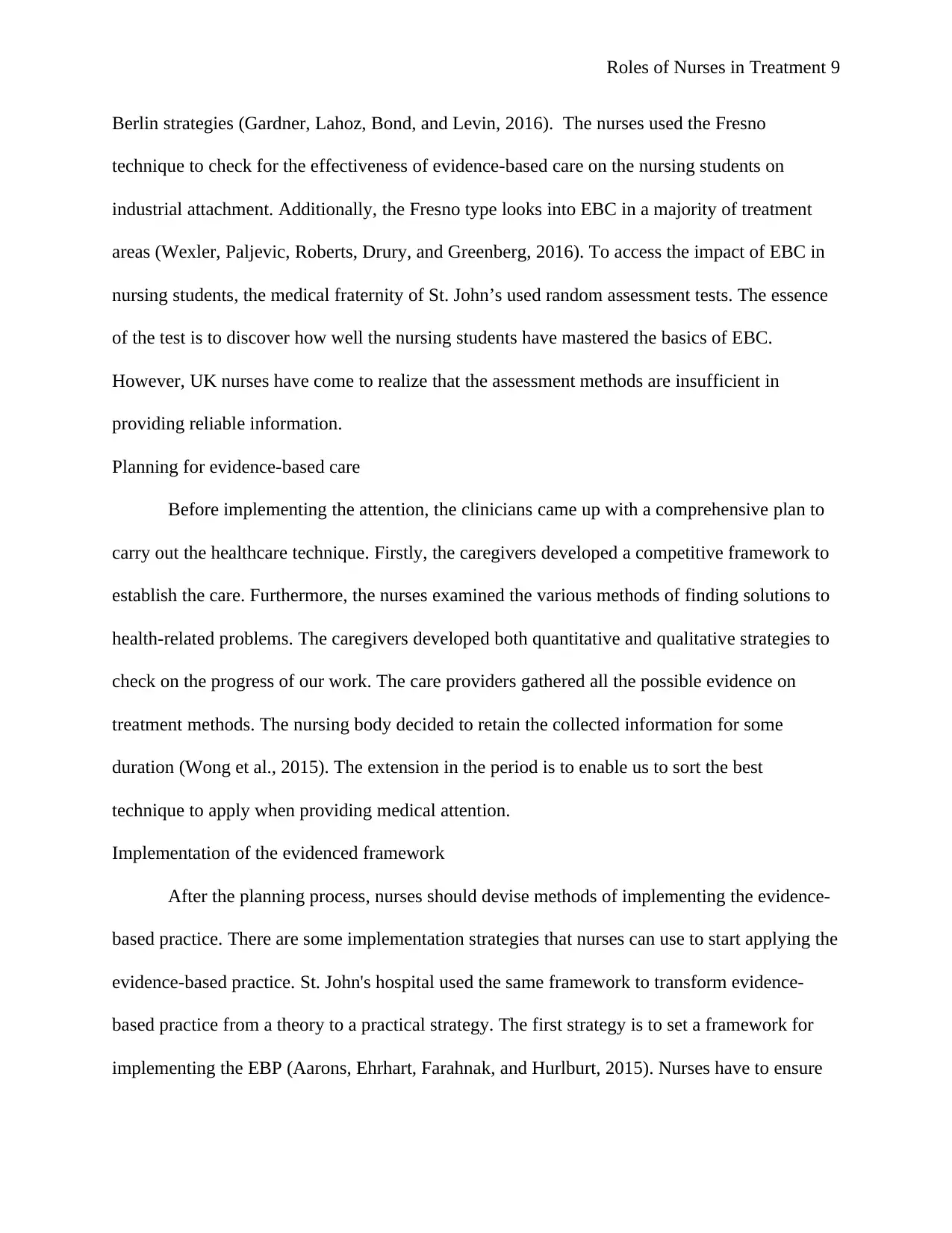
Roles of Nurses in Treatment 9
Berlin strategies (Gardner, Lahoz, Bond, and Levin, 2016). The nurses used the Fresno
technique to check for the effectiveness of evidence-based care on the nursing students on
industrial attachment. Additionally, the Fresno type looks into EBC in a majority of treatment
areas (Wexler, Paljevic, Roberts, Drury, and Greenberg, 2016). To access the impact of EBC in
nursing students, the medical fraternity of St. John’s used random assessment tests. The essence
of the test is to discover how well the nursing students have mastered the basics of EBC.
However, UK nurses have come to realize that the assessment methods are insufficient in
providing reliable information.
Planning for evidence-based care
Before implementing the attention, the clinicians came up with a comprehensive plan to
carry out the healthcare technique. Firstly, the caregivers developed a competitive framework to
establish the care. Furthermore, the nurses examined the various methods of finding solutions to
health-related problems. The caregivers developed both quantitative and qualitative strategies to
check on the progress of our work. The care providers gathered all the possible evidence on
treatment methods. The nursing body decided to retain the collected information for some
duration (Wong et al., 2015). The extension in the period is to enable us to sort the best
technique to apply when providing medical attention.
Implementation of the evidenced framework
After the planning process, nurses should devise methods of implementing the evidence-
based practice. There are some implementation strategies that nurses can use to start applying the
evidence-based practice. St. John's hospital used the same framework to transform evidence-
based practice from a theory to a practical strategy. The first strategy is to set a framework for
implementing the EBP (Aarons, Ehrhart, Farahnak, and Hurlburt, 2015). Nurses have to ensure
Berlin strategies (Gardner, Lahoz, Bond, and Levin, 2016). The nurses used the Fresno
technique to check for the effectiveness of evidence-based care on the nursing students on
industrial attachment. Additionally, the Fresno type looks into EBC in a majority of treatment
areas (Wexler, Paljevic, Roberts, Drury, and Greenberg, 2016). To access the impact of EBC in
nursing students, the medical fraternity of St. John’s used random assessment tests. The essence
of the test is to discover how well the nursing students have mastered the basics of EBC.
However, UK nurses have come to realize that the assessment methods are insufficient in
providing reliable information.
Planning for evidence-based care
Before implementing the attention, the clinicians came up with a comprehensive plan to
carry out the healthcare technique. Firstly, the caregivers developed a competitive framework to
establish the care. Furthermore, the nurses examined the various methods of finding solutions to
health-related problems. The caregivers developed both quantitative and qualitative strategies to
check on the progress of our work. The care providers gathered all the possible evidence on
treatment methods. The nursing body decided to retain the collected information for some
duration (Wong et al., 2015). The extension in the period is to enable us to sort the best
technique to apply when providing medical attention.
Implementation of the evidenced framework
After the planning process, nurses should devise methods of implementing the evidence-
based practice. There are some implementation strategies that nurses can use to start applying the
evidence-based practice. St. John's hospital used the same framework to transform evidence-
based practice from a theory to a practical strategy. The first strategy is to set a framework for
implementing the EBP (Aarons, Ehrhart, Farahnak, and Hurlburt, 2015). Nurses have to ensure
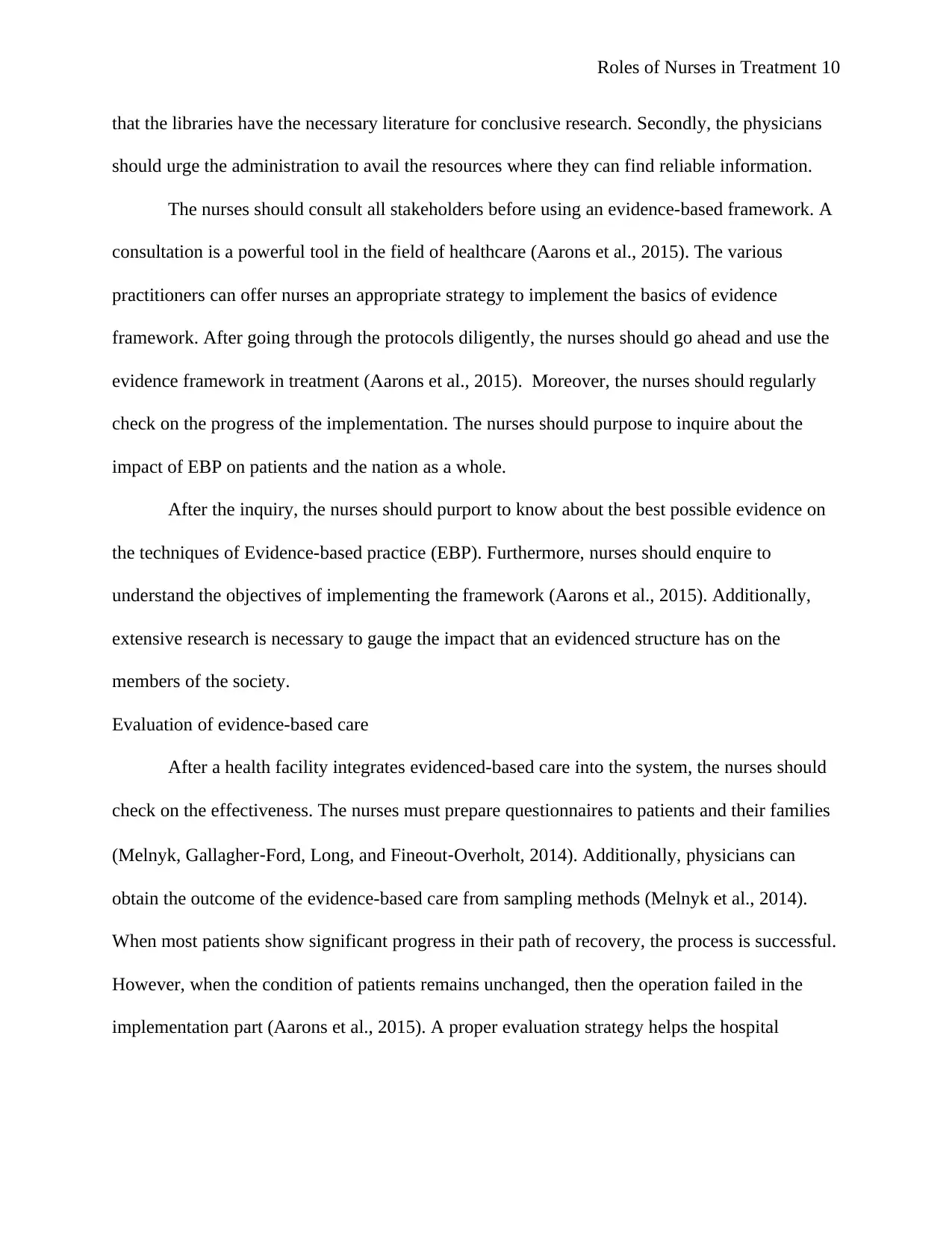
Roles of Nurses in Treatment 10
that the libraries have the necessary literature for conclusive research. Secondly, the physicians
should urge the administration to avail the resources where they can find reliable information.
The nurses should consult all stakeholders before using an evidence-based framework. A
consultation is a powerful tool in the field of healthcare (Aarons et al., 2015). The various
practitioners can offer nurses an appropriate strategy to implement the basics of evidence
framework. After going through the protocols diligently, the nurses should go ahead and use the
evidence framework in treatment (Aarons et al., 2015). Moreover, the nurses should regularly
check on the progress of the implementation. The nurses should purpose to inquire about the
impact of EBP on patients and the nation as a whole.
After the inquiry, the nurses should purport to know about the best possible evidence on
the techniques of Evidence-based practice (EBP). Furthermore, nurses should enquire to
understand the objectives of implementing the framework (Aarons et al., 2015). Additionally,
extensive research is necessary to gauge the impact that an evidenced structure has on the
members of the society.
Evaluation of evidence-based care
After a health facility integrates evidenced-based care into the system, the nurses should
check on the effectiveness. The nurses must prepare questionnaires to patients and their families
(Melnyk, Gallagher‐Ford, Long, and Fineout‐Overholt, 2014). Additionally, physicians can
obtain the outcome of the evidence-based care from sampling methods (Melnyk et al., 2014).
When most patients show significant progress in their path of recovery, the process is successful.
However, when the condition of patients remains unchanged, then the operation failed in the
implementation part (Aarons et al., 2015). A proper evaluation strategy helps the hospital
that the libraries have the necessary literature for conclusive research. Secondly, the physicians
should urge the administration to avail the resources where they can find reliable information.
The nurses should consult all stakeholders before using an evidence-based framework. A
consultation is a powerful tool in the field of healthcare (Aarons et al., 2015). The various
practitioners can offer nurses an appropriate strategy to implement the basics of evidence
framework. After going through the protocols diligently, the nurses should go ahead and use the
evidence framework in treatment (Aarons et al., 2015). Moreover, the nurses should regularly
check on the progress of the implementation. The nurses should purpose to inquire about the
impact of EBP on patients and the nation as a whole.
After the inquiry, the nurses should purport to know about the best possible evidence on
the techniques of Evidence-based practice (EBP). Furthermore, nurses should enquire to
understand the objectives of implementing the framework (Aarons et al., 2015). Additionally,
extensive research is necessary to gauge the impact that an evidenced structure has on the
members of the society.
Evaluation of evidence-based care
After a health facility integrates evidenced-based care into the system, the nurses should
check on the effectiveness. The nurses must prepare questionnaires to patients and their families
(Melnyk, Gallagher‐Ford, Long, and Fineout‐Overholt, 2014). Additionally, physicians can
obtain the outcome of the evidence-based care from sampling methods (Melnyk et al., 2014).
When most patients show significant progress in their path of recovery, the process is successful.
However, when the condition of patients remains unchanged, then the operation failed in the
implementation part (Aarons et al., 2015). A proper evaluation strategy helps the hospital
Secure Best Marks with AI Grader
Need help grading? Try our AI Grader for instant feedback on your assignments.
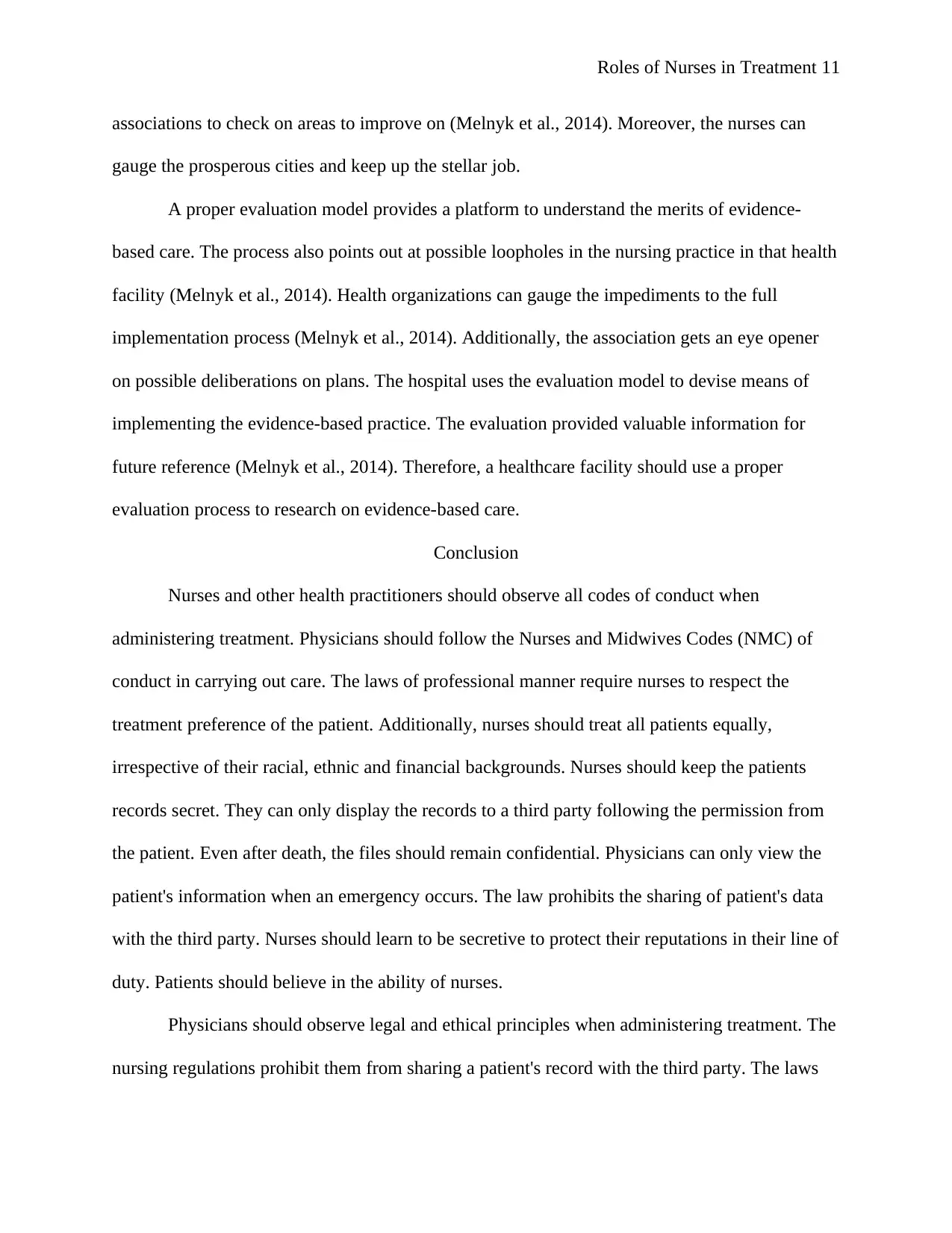
Roles of Nurses in Treatment 11
associations to check on areas to improve on (Melnyk et al., 2014). Moreover, the nurses can
gauge the prosperous cities and keep up the stellar job.
A proper evaluation model provides a platform to understand the merits of evidence-
based care. The process also points out at possible loopholes in the nursing practice in that health
facility (Melnyk et al., 2014). Health organizations can gauge the impediments to the full
implementation process (Melnyk et al., 2014). Additionally, the association gets an eye opener
on possible deliberations on plans. The hospital uses the evaluation model to devise means of
implementing the evidence-based practice. The evaluation provided valuable information for
future reference (Melnyk et al., 2014). Therefore, a healthcare facility should use a proper
evaluation process to research on evidence-based care.
Conclusion
Nurses and other health practitioners should observe all codes of conduct when
administering treatment. Physicians should follow the Nurses and Midwives Codes (NMC) of
conduct in carrying out care. The laws of professional manner require nurses to respect the
treatment preference of the patient. Additionally, nurses should treat all patients equally,
irrespective of their racial, ethnic and financial backgrounds. Nurses should keep the patients
records secret. They can only display the records to a third party following the permission from
the patient. Even after death, the files should remain confidential. Physicians can only view the
patient's information when an emergency occurs. The law prohibits the sharing of patient's data
with the third party. Nurses should learn to be secretive to protect their reputations in their line of
duty. Patients should believe in the ability of nurses.
Physicians should observe legal and ethical principles when administering treatment. The
nursing regulations prohibit them from sharing a patient's record with the third party. The laws
associations to check on areas to improve on (Melnyk et al., 2014). Moreover, the nurses can
gauge the prosperous cities and keep up the stellar job.
A proper evaluation model provides a platform to understand the merits of evidence-
based care. The process also points out at possible loopholes in the nursing practice in that health
facility (Melnyk et al., 2014). Health organizations can gauge the impediments to the full
implementation process (Melnyk et al., 2014). Additionally, the association gets an eye opener
on possible deliberations on plans. The hospital uses the evaluation model to devise means of
implementing the evidence-based practice. The evaluation provided valuable information for
future reference (Melnyk et al., 2014). Therefore, a healthcare facility should use a proper
evaluation process to research on evidence-based care.
Conclusion
Nurses and other health practitioners should observe all codes of conduct when
administering treatment. Physicians should follow the Nurses and Midwives Codes (NMC) of
conduct in carrying out care. The laws of professional manner require nurses to respect the
treatment preference of the patient. Additionally, nurses should treat all patients equally,
irrespective of their racial, ethnic and financial backgrounds. Nurses should keep the patients
records secret. They can only display the records to a third party following the permission from
the patient. Even after death, the files should remain confidential. Physicians can only view the
patient's information when an emergency occurs. The law prohibits the sharing of patient's data
with the third party. Nurses should learn to be secretive to protect their reputations in their line of
duty. Patients should believe in the ability of nurses.
Physicians should observe legal and ethical principles when administering treatment. The
nursing regulations prohibit them from sharing a patient's record with the third party. The laws
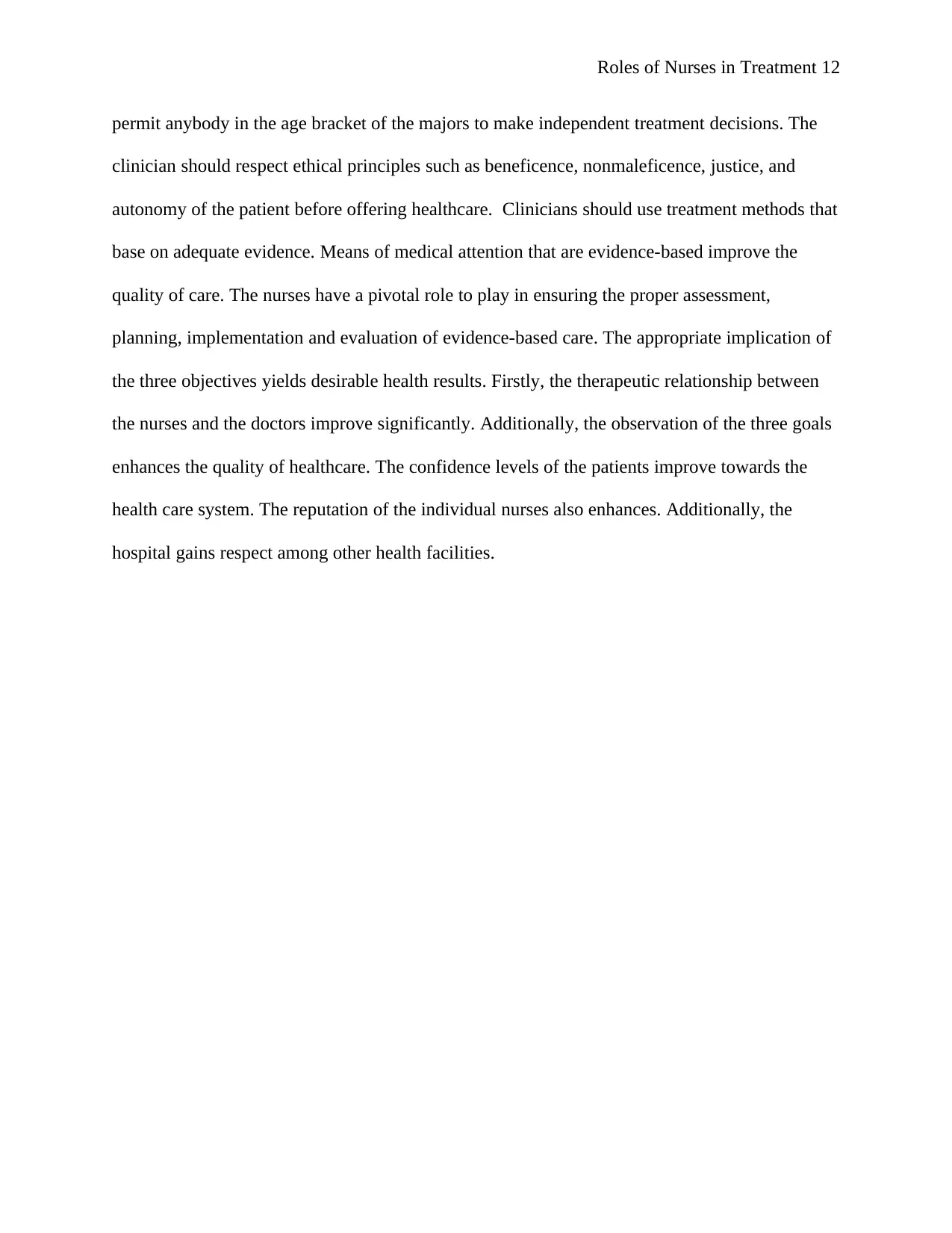
Roles of Nurses in Treatment 12
permit anybody in the age bracket of the majors to make independent treatment decisions. The
clinician should respect ethical principles such as beneficence, nonmaleficence, justice, and
autonomy of the patient before offering healthcare. Clinicians should use treatment methods that
base on adequate evidence. Means of medical attention that are evidence-based improve the
quality of care. The nurses have a pivotal role to play in ensuring the proper assessment,
planning, implementation and evaluation of evidence-based care. The appropriate implication of
the three objectives yields desirable health results. Firstly, the therapeutic relationship between
the nurses and the doctors improve significantly. Additionally, the observation of the three goals
enhances the quality of healthcare. The confidence levels of the patients improve towards the
health care system. The reputation of the individual nurses also enhances. Additionally, the
hospital gains respect among other health facilities.
permit anybody in the age bracket of the majors to make independent treatment decisions. The
clinician should respect ethical principles such as beneficence, nonmaleficence, justice, and
autonomy of the patient before offering healthcare. Clinicians should use treatment methods that
base on adequate evidence. Means of medical attention that are evidence-based improve the
quality of care. The nurses have a pivotal role to play in ensuring the proper assessment,
planning, implementation and evaluation of evidence-based care. The appropriate implication of
the three objectives yields desirable health results. Firstly, the therapeutic relationship between
the nurses and the doctors improve significantly. Additionally, the observation of the three goals
enhances the quality of healthcare. The confidence levels of the patients improve towards the
health care system. The reputation of the individual nurses also enhances. Additionally, the
hospital gains respect among other health facilities.
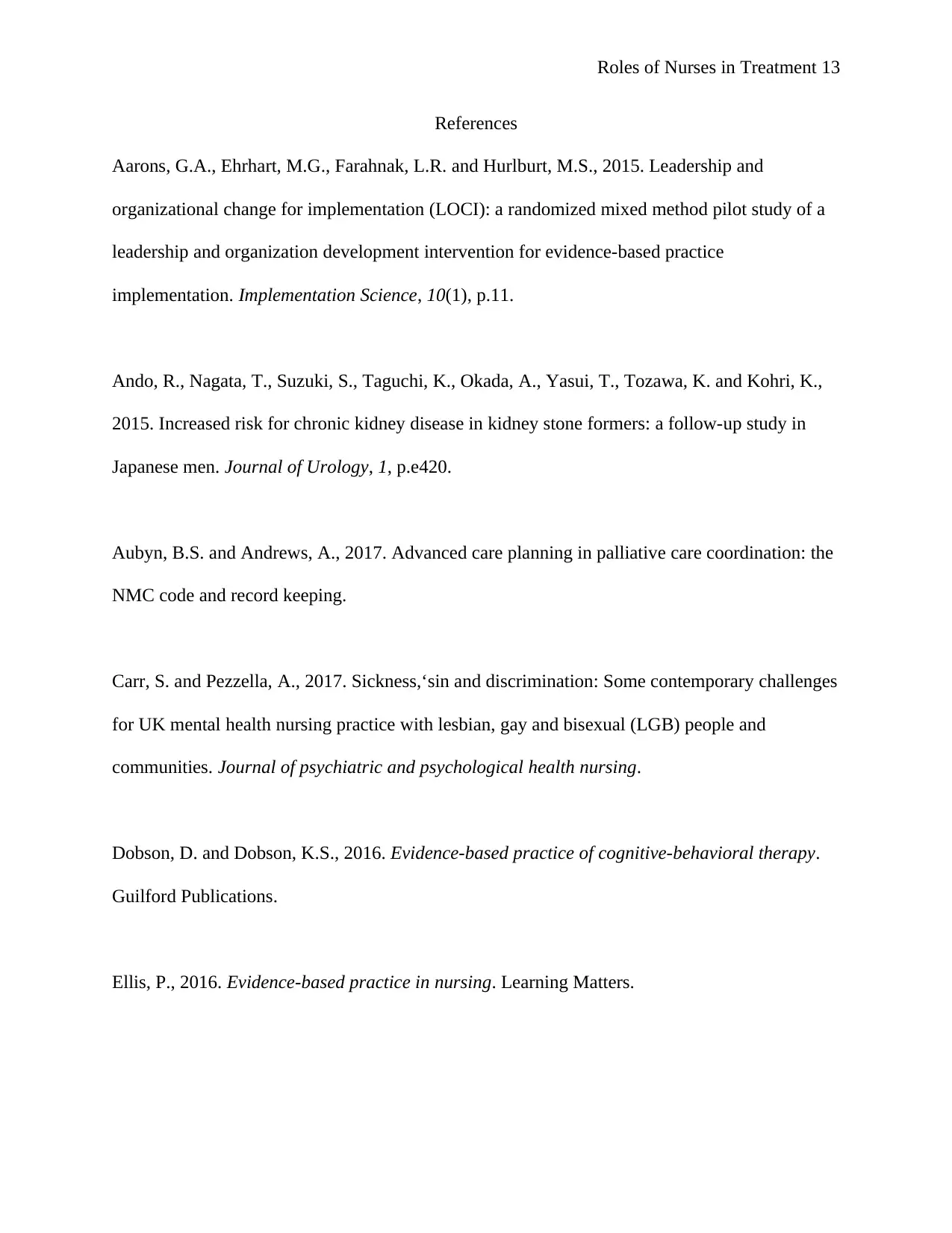
Roles of Nurses in Treatment 13
References
Aarons, G.A., Ehrhart, M.G., Farahnak, L.R. and Hurlburt, M.S., 2015. Leadership and
organizational change for implementation (LOCI): a randomized mixed method pilot study of a
leadership and organization development intervention for evidence-based practice
implementation. Implementation Science, 10(1), p.11.
Ando, R., Nagata, T., Suzuki, S., Taguchi, K., Okada, A., Yasui, T., Tozawa, K. and Kohri, K.,
2015. Increased risk for chronic kidney disease in kidney stone formers: a follow-up study in
Japanese men. Journal of Urology, 1, p.e420.
Aubyn, B.S. and Andrews, A., 2017. Advanced care planning in palliative care coordination: the
NMC code and record keeping.
Carr, S. and Pezzella, A., 2017. Sickness,‘sin and discrimination: Some contemporary challenges
for UK mental health nursing practice with lesbian, gay and bisexual (LGB) people and
communities. Journal of psychiatric and psychological health nursing.
Dobson, D. and Dobson, K.S., 2016. Evidence-based practice of cognitive-behavioral therapy.
Guilford Publications.
Ellis, P., 2016. Evidence-based practice in nursing. Learning Matters.
References
Aarons, G.A., Ehrhart, M.G., Farahnak, L.R. and Hurlburt, M.S., 2015. Leadership and
organizational change for implementation (LOCI): a randomized mixed method pilot study of a
leadership and organization development intervention for evidence-based practice
implementation. Implementation Science, 10(1), p.11.
Ando, R., Nagata, T., Suzuki, S., Taguchi, K., Okada, A., Yasui, T., Tozawa, K. and Kohri, K.,
2015. Increased risk for chronic kidney disease in kidney stone formers: a follow-up study in
Japanese men. Journal of Urology, 1, p.e420.
Aubyn, B.S. and Andrews, A., 2017. Advanced care planning in palliative care coordination: the
NMC code and record keeping.
Carr, S. and Pezzella, A., 2017. Sickness,‘sin and discrimination: Some contemporary challenges
for UK mental health nursing practice with lesbian, gay and bisexual (LGB) people and
communities. Journal of psychiatric and psychological health nursing.
Dobson, D. and Dobson, K.S., 2016. Evidence-based practice of cognitive-behavioral therapy.
Guilford Publications.
Ellis, P., 2016. Evidence-based practice in nursing. Learning Matters.
Paraphrase This Document
Need a fresh take? Get an instant paraphrase of this document with our AI Paraphraser
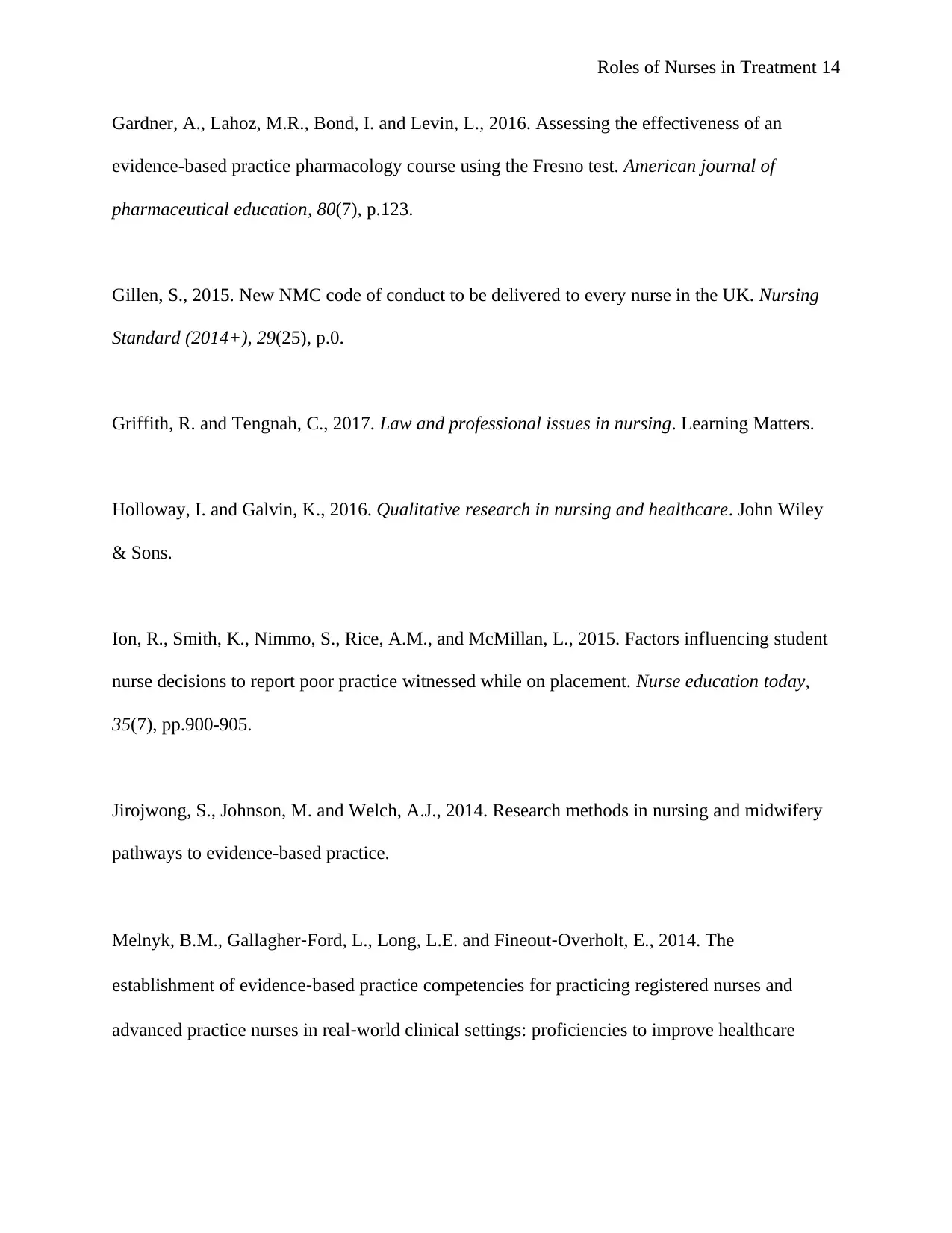
Roles of Nurses in Treatment 14
Gardner, A., Lahoz, M.R., Bond, I. and Levin, L., 2016. Assessing the effectiveness of an
evidence-based practice pharmacology course using the Fresno test. American journal of
pharmaceutical education, 80(7), p.123.
Gillen, S., 2015. New NMC code of conduct to be delivered to every nurse in the UK. Nursing
Standard (2014+), 29(25), p.0.
Griffith, R. and Tengnah, C., 2017. Law and professional issues in nursing. Learning Matters.
Holloway, I. and Galvin, K., 2016. Qualitative research in nursing and healthcare. John Wiley
& Sons.
Ion, R., Smith, K., Nimmo, S., Rice, A.M., and McMillan, L., 2015. Factors influencing student
nurse decisions to report poor practice witnessed while on placement. Nurse education today,
35(7), pp.900-905.
Jirojwong, S., Johnson, M. and Welch, A.J., 2014. Research methods in nursing and midwifery
pathways to evidence-based practice.
Melnyk, B.M., Gallagher‐Ford, L., Long, L.E. and Fineout‐Overholt, E., 2014. The
establishment of evidence‐based practice competencies for practicing registered nurses and
advanced practice nurses in real‐world clinical settings: proficiencies to improve healthcare
Gardner, A., Lahoz, M.R., Bond, I. and Levin, L., 2016. Assessing the effectiveness of an
evidence-based practice pharmacology course using the Fresno test. American journal of
pharmaceutical education, 80(7), p.123.
Gillen, S., 2015. New NMC code of conduct to be delivered to every nurse in the UK. Nursing
Standard (2014+), 29(25), p.0.
Griffith, R. and Tengnah, C., 2017. Law and professional issues in nursing. Learning Matters.
Holloway, I. and Galvin, K., 2016. Qualitative research in nursing and healthcare. John Wiley
& Sons.
Ion, R., Smith, K., Nimmo, S., Rice, A.M., and McMillan, L., 2015. Factors influencing student
nurse decisions to report poor practice witnessed while on placement. Nurse education today,
35(7), pp.900-905.
Jirojwong, S., Johnson, M. and Welch, A.J., 2014. Research methods in nursing and midwifery
pathways to evidence-based practice.
Melnyk, B.M., Gallagher‐Ford, L., Long, L.E. and Fineout‐Overholt, E., 2014. The
establishment of evidence‐based practice competencies for practicing registered nurses and
advanced practice nurses in real‐world clinical settings: proficiencies to improve healthcare
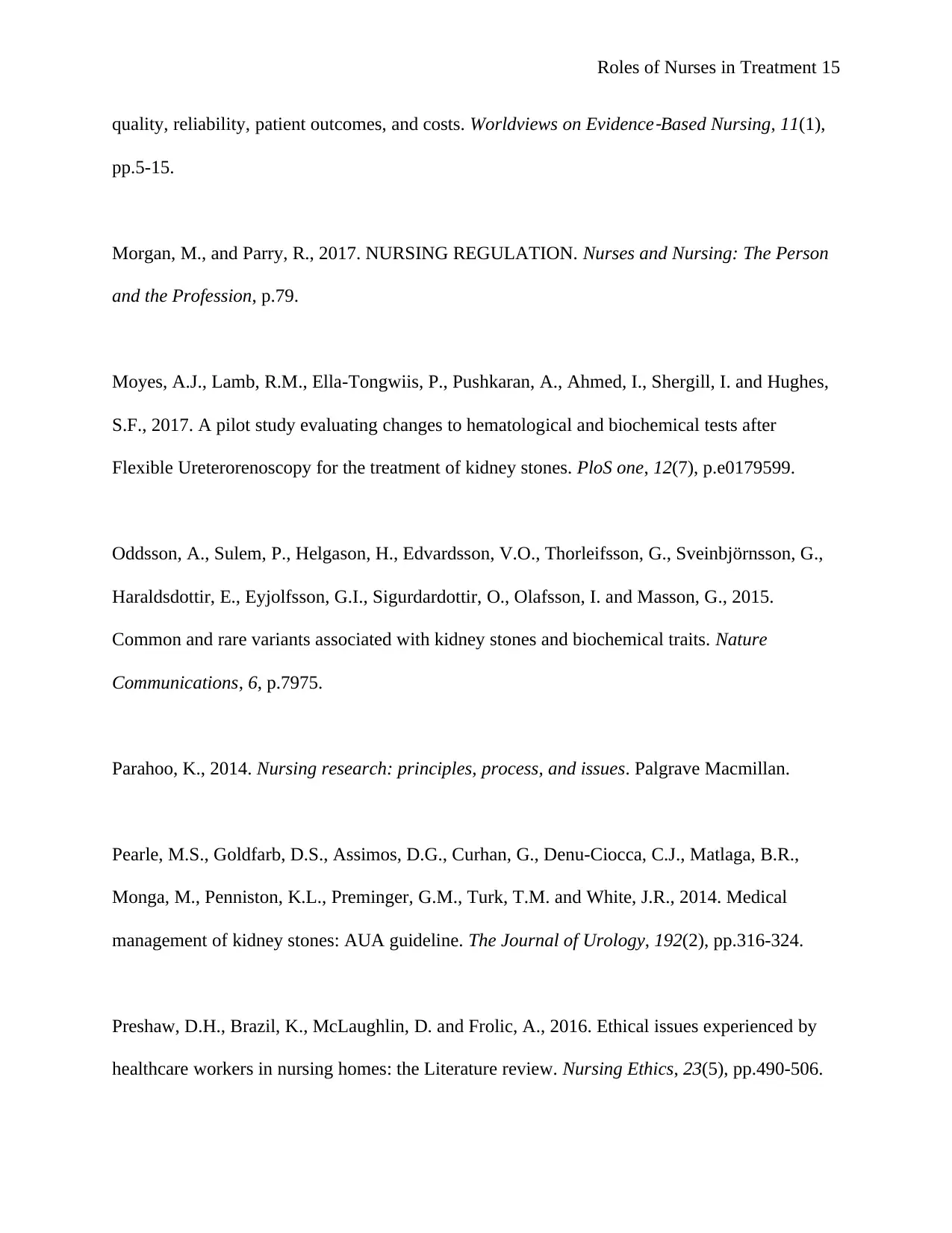
Roles of Nurses in Treatment 15
quality, reliability, patient outcomes, and costs. Worldviews on Evidence
‐Based Nursing, 11(1),
pp.5-15.
Morgan, M., and Parry, R., 2017. NURSING REGULATION. Nurses and Nursing: The Person
and the Profession, p.79.
Moyes, A.J., Lamb, R.M., Ella-Tongwiis, P., Pushkaran, A., Ahmed, I., Shergill, I. and Hughes,
S.F., 2017. A pilot study evaluating changes to hematological and biochemical tests after
Flexible Ureterorenoscopy for the treatment of kidney stones. PloS one, 12(7), p.e0179599.
Oddsson, A., Sulem, P., Helgason, H., Edvardsson, V.O., Thorleifsson, G., Sveinbjörnsson, G.,
Haraldsdottir, E., Eyjolfsson, G.I., Sigurdardottir, O., Olafsson, I. and Masson, G., 2015.
Common and rare variants associated with kidney stones and biochemical traits. Nature
Communications, 6, p.7975.
Parahoo, K., 2014. Nursing research: principles, process, and issues. Palgrave Macmillan.
Pearle, M.S., Goldfarb, D.S., Assimos, D.G., Curhan, G., Denu-Ciocca, C.J., Matlaga, B.R.,
Monga, M., Penniston, K.L., Preminger, G.M., Turk, T.M. and White, J.R., 2014. Medical
management of kidney stones: AUA guideline. The Journal of Urology, 192(2), pp.316-324.
Preshaw, D.H., Brazil, K., McLaughlin, D. and Frolic, A., 2016. Ethical issues experienced by
healthcare workers in nursing homes: the Literature review. Nursing Ethics, 23(5), pp.490-506.
quality, reliability, patient outcomes, and costs. Worldviews on Evidence
‐Based Nursing, 11(1),
pp.5-15.
Morgan, M., and Parry, R., 2017. NURSING REGULATION. Nurses and Nursing: The Person
and the Profession, p.79.
Moyes, A.J., Lamb, R.M., Ella-Tongwiis, P., Pushkaran, A., Ahmed, I., Shergill, I. and Hughes,
S.F., 2017. A pilot study evaluating changes to hematological and biochemical tests after
Flexible Ureterorenoscopy for the treatment of kidney stones. PloS one, 12(7), p.e0179599.
Oddsson, A., Sulem, P., Helgason, H., Edvardsson, V.O., Thorleifsson, G., Sveinbjörnsson, G.,
Haraldsdottir, E., Eyjolfsson, G.I., Sigurdardottir, O., Olafsson, I. and Masson, G., 2015.
Common and rare variants associated with kidney stones and biochemical traits. Nature
Communications, 6, p.7975.
Parahoo, K., 2014. Nursing research: principles, process, and issues. Palgrave Macmillan.
Pearle, M.S., Goldfarb, D.S., Assimos, D.G., Curhan, G., Denu-Ciocca, C.J., Matlaga, B.R.,
Monga, M., Penniston, K.L., Preminger, G.M., Turk, T.M. and White, J.R., 2014. Medical
management of kidney stones: AUA guideline. The Journal of Urology, 192(2), pp.316-324.
Preshaw, D.H., Brazil, K., McLaughlin, D. and Frolic, A., 2016. Ethical issues experienced by
healthcare workers in nursing homes: the Literature review. Nursing Ethics, 23(5), pp.490-506.
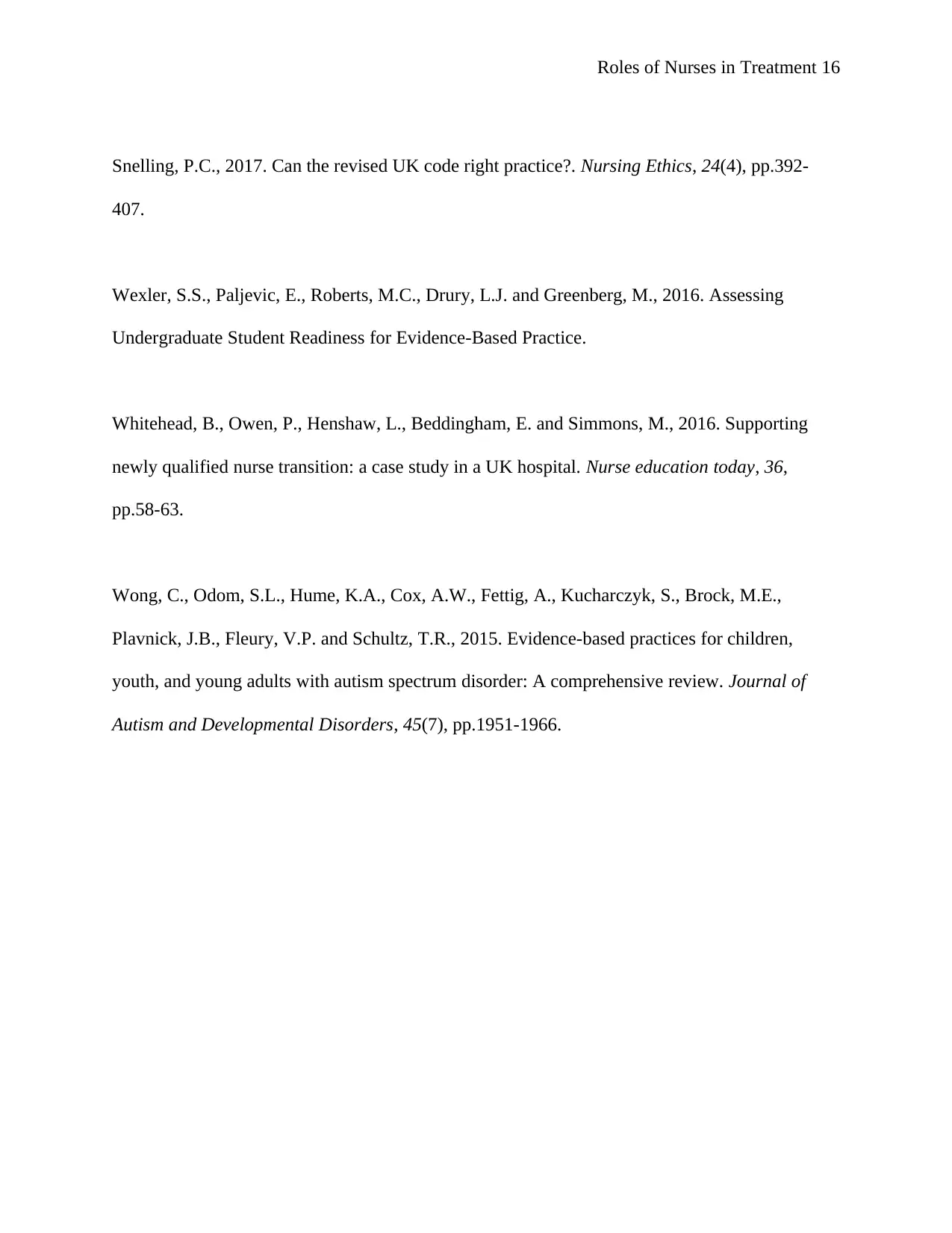
Roles of Nurses in Treatment 16
Snelling, P.C., 2017. Can the revised UK code right practice?. Nursing Ethics, 24(4), pp.392-
407.
Wexler, S.S., Paljevic, E., Roberts, M.C., Drury, L.J. and Greenberg, M., 2016. Assessing
Undergraduate Student Readiness for Evidence-Based Practice.
Whitehead, B., Owen, P., Henshaw, L., Beddingham, E. and Simmons, M., 2016. Supporting
newly qualified nurse transition: a case study in a UK hospital. Nurse education today, 36,
pp.58-63.
Wong, C., Odom, S.L., Hume, K.A., Cox, A.W., Fettig, A., Kucharczyk, S., Brock, M.E.,
Plavnick, J.B., Fleury, V.P. and Schultz, T.R., 2015. Evidence-based practices for children,
youth, and young adults with autism spectrum disorder: A comprehensive review. Journal of
Autism and Developmental Disorders, 45(7), pp.1951-1966.
Snelling, P.C., 2017. Can the revised UK code right practice?. Nursing Ethics, 24(4), pp.392-
407.
Wexler, S.S., Paljevic, E., Roberts, M.C., Drury, L.J. and Greenberg, M., 2016. Assessing
Undergraduate Student Readiness for Evidence-Based Practice.
Whitehead, B., Owen, P., Henshaw, L., Beddingham, E. and Simmons, M., 2016. Supporting
newly qualified nurse transition: a case study in a UK hospital. Nurse education today, 36,
pp.58-63.
Wong, C., Odom, S.L., Hume, K.A., Cox, A.W., Fettig, A., Kucharczyk, S., Brock, M.E.,
Plavnick, J.B., Fleury, V.P. and Schultz, T.R., 2015. Evidence-based practices for children,
youth, and young adults with autism spectrum disorder: A comprehensive review. Journal of
Autism and Developmental Disorders, 45(7), pp.1951-1966.
1 out of 16
Related Documents
Your All-in-One AI-Powered Toolkit for Academic Success.
+13062052269
info@desklib.com
Available 24*7 on WhatsApp / Email
![[object Object]](/_next/static/media/star-bottom.7253800d.svg)
Unlock your academic potential
© 2024 | Zucol Services PVT LTD | All rights reserved.




